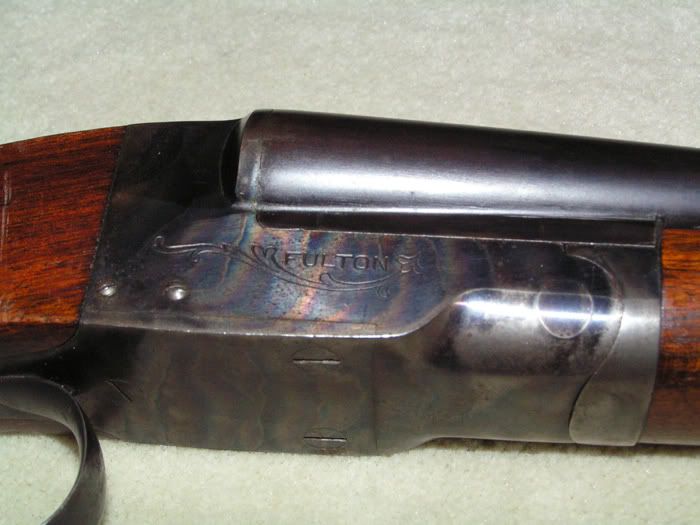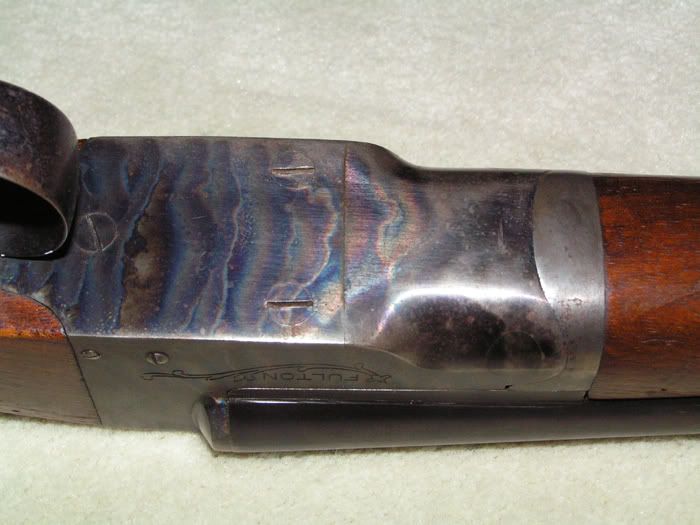|
S |
M |
T |
W |
T |
F |
S |
|
|
1
|
2
|
3
|
4
|
5
|
6
|
|
7
|
8
|
9
|
10
|
11
|
12
|
13
|
|
14
|
15
|
16
|
17
|
18
|
19
|
20
|
|
21
|
22
|
23
|
24
|
25
|
26
|
27
|
|
28
|
29
|
30
|
|
|
|
|
|
|
7 members (Der Ami, Ian Forrester, Karl Graebner, ClapperZapper, graybeardtmm3, bushveld),
1,090
guests, and
4
robots. |
|
Key:
Admin,
Global Mod,
Mod
|
|
|
Forums10
Topics38,481
Posts545,238
Members14,410
| |
Most Online1,335
Apr 27th, 2024
|
|
|
|
Joined: Mar 2005
Posts: 680
Sidelock
|

Sidelock
Joined: Mar 2005
Posts: 680 |
I have noted that certain low end guns seem to retain their colors better than highly finished (well polished) surface of higher grade guns. Case in point I have a Hunter Arms Fulton that retains almost all of its color after 70 years while most of my A H Fox guns with about the same or less level of use are starting to fade or wear off. It seems to me that perhaps the surface preparation of the item being color case hardened would have a bearing on the durability of the case colors with courser surfaces retaining colors better. This is a very limited observation but I have seen many Savage 311's and Fox Model Bs that exhibit the same resistance to color wear. Both the Savage 311s and the Fox Model Bs have the same cyanide colors as the A H Fox guns. Any one have any thoughts on this?
|
|
|
|
|
Joined: Feb 2009
Posts: 7,463 Likes: 212
Sidelock
|

Sidelock
Joined: Feb 2009
Posts: 7,463 Likes: 212 |
Where might I find Dr. Gaddy's studies on case hardening? I've seen articles in Double Gun Journal on his techniques, but haven't seen any in depth analysis of case color chemistry....
That part one of Doc Gaddy's article seems to go into the chemistry pretty significantly, from about half way down to the end of the piece. I believe iron oxide, colors, formed during the normal tempering of steel is what he implies is the known baseline. His article seems to detail how the traditional cch process arranges the iron oxide in a unique way. It could be that you are wearing against some protective coating on your muzzle loader and not the colors. I've heard of many different coatings recommended for case colors. Some of them aren't too durable for their normal use, so I tend to wonder why they would suddenly protect metal colors very effectively.
|
|
|
|
|
Joined: Jul 2008
Posts: 1,008
Sidelock
|

Sidelock
Joined: Jul 2008
Posts: 1,008 |
As I recall, Dr. Gaddy found the "stuff" in the layers to be very complex and not necessarily uniform. The layer thickness is important to the color, not the composition. Differing compositions can/do create equal thickness layers which cause the same color. Given colors are not associated with given compositions, to my knowledge.
I agree that strong basic (high Ph) would likely attack CCH.
Interesting discussion!
DDA The fact that different compositions can cause the same color is because the colors are optical interference colors and not due to the intrinsic color of the surface layer. If you look at (not through) your camera or binocular lens you will see a blue or reddish color - that is NOT a pigment, but an optical interference color produced in the same way colors are on case-hardened guns. The visible colors are the net effect of refractive index of the layer (causing different retardation at different wavelengths), the reflectivity of the substrate and the light once again bouncing outward thru the layers. It's an unusual concept - case colors are not at all like the pigment colors of paint - they are the result of the physical properties of light and interference.
|
|
|
|
|
Joined: Feb 2009
Posts: 7,463 Likes: 212
Sidelock
|

Sidelock
Joined: Feb 2009
Posts: 7,463 Likes: 212 |
....The fact that different compositions can cause the same color is because the colors are optical interference colors and not due to the intrinsic color of the surface layer.
If you look at (not through) your camera or binocular lens you will see a blue or reddish color - that is NOT a pigment, but an optical interference color produced in the same way colors are on case-hardened guns.... I think that's what Rocketman was saying. Supposedly, it's not the color of the 'stuff', it's the thickness of the layer that make the colors appear to be different. Maybe though, there is a 'pigment' effect. The Gaddy article specifically points out that case colors do not change appreciably when viewed at different angles, which happens with your optical interference example. Heat affected steel, like temper colors, seems to show changeable colors due to minute differences in the thickness of the iron oxide, but is otherwise a 'flat' layer. Case colors seem to have a component of optical interference, but those opaque 'globs' of iron oxide described in the article seem to be of big enough size to be a pigment and have some contribution to the final color. In the end though, it seems to be just one ingredient, iron oxide, with very little other trace components. Interesting stuff. Not trying to be contrary, seems that true case colors are more complicated than eek torch colors.
|
|
|
|
|
Joined: Jul 2008
Posts: 1,008
Sidelock
|

Sidelock
Joined: Jul 2008
Posts: 1,008 |
"...Maybe though, there is a 'pigment' effect. The Gaddy article specifically points out that case colors do not change appreciably when viewed at different angles, which happens with your optical interference example...."
If the layer is uniform the colors do not change at different angles - you can try that on a binocular lens - usually those coatings, if bluish, are 1/4-wave
An oil drop on a puddle will demonstrate different colors because it isn't uniform thickness. The oil has the same refractive index over the entire spread-out drop but its thickness varies and the interference fringes consequently have different colors.
Certainly if there's a big "glob" of oxide on the surface that will act as a real pigment as far as color goes.
|
|
|
|
|
Joined: Feb 2008
Posts: 11,343 Likes: 390
Sidelock
|
OP

Sidelock
Joined: Feb 2008
Posts: 11,343 Likes: 390 |
TwiceBarrel, I noticed the same thing about the colors on my Hunter Arms Fulton, and many other Fulton's I've seen. I don't know if it's the steel or the process they used, but their colors seem to hold up much better than Hunter Arms L. C. Smith guns in the same overall condition. They do look a bit like cyanide colors so I wonder if they used a bone charcoal pack method with cyanide added. I've read that this works but is seldom used because of the risk.
Craigd, my T/C flintlock never had any protective coating on the lock. They do use investment cast parts and the level of polish is not super high. Whatever the reason, the colors are attractive and exceptionally durable.
A true sign of mental illness is any gun owner who would vote for an Anti-Gunner like Joe Biden.
|
|
|
|
|
Joined: Feb 2004
Posts: 13,879 Likes: 15
Sidelock
|

Sidelock
Joined: Feb 2004
Posts: 13,879 Likes: 15 |
Keith, I believe my Fulton is cyanide casehardened.  
|
|
|
|
|
Joined: Feb 2008
Posts: 11,343 Likes: 390
Sidelock
|
OP

Sidelock
Joined: Feb 2008
Posts: 11,343 Likes: 390 |
Chuck, I would have to agree that those are cyanide case colors. My Fulton has colors which look like more traditional bone pack colors, but they do have some of that distinctive "overlap" of color pattern which seems to be a characteristic of cyanide colors. That's why I thought they may have used cyanide added to the bone pack. As I said, I have read some reference to that, but I don't even know if it's really done. It would seem kind of odd that Hunter Arms would use multiple processes on a lower grade gun unless it was a change they went to to reduce costs.
A true sign of mental illness is any gun owner who would vote for an Anti-Gunner like Joe Biden.
|
|
|
|
|